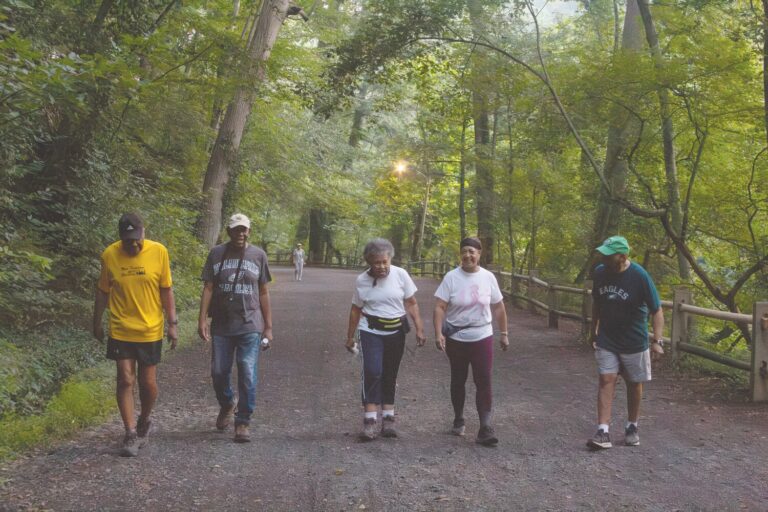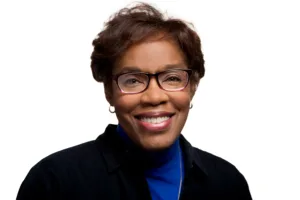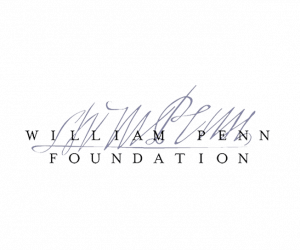Amid Grief in Germantown, The Wissahickon Endures as a Place of Comfort and Connection

By Kristen E. Holmes
This story was originally published by the Chestnut Hill Local.
At first, Carlotta Fareira and Harrison Tate Jr. passed each other with only a nod of recognition as they navigated Forbidden Drive in the early morning hours.
Fareira ran in Wissahickon Valley Park as a brief escape from a troubled marriage and the crush of raising two children. Tate, 15 years younger, walked the trail as a way to exhale when the middle school students he taught acted like middle schoolers.
“One day, I just said hello,” said Tate, of Roxborough. That greeting occurred more than 42 years ago and has since led to a friendship cemented by a love of the Wissahickon. Their connection multiplied as well, and these days, Fareira, now 92, and Tate, 77, aren’t the only ones walking together.
For a group of people who have traversed Wissahickon Valley Park together for decades, the 2,000-acre expanse that winds through Northwest Philadelphia is an elixir. A walk along the path, shaded by an arch of chestnut oak trees, with the sound of crickets and the crunch of sneakers on gravel, can act as both a salve and a soundtrack for the affirmation of friendship.
6 a.m. or 9 a.m.
In the 42 years since Tate and Fareira have walked together, two groups of friends who walk have formed. One group of roughly six people sets out at 6 a.m., the other, about the same number, at 9 a.m. Both meet at the 175-year-old historic Valley Green Inn approximately five-days a week.
“We hardly knew each other’s names at first; I recognized them by their gait,” said Fareira, a retired teacher from Mt. Airy. “We’d just say ‘Hi,’ and keep going, but eventually we knew their names and learned a little about them and their families. Then, it became a real community who cared about each other.”
The friends who walk worked as teachers, doctors, police officers, real estate agents, contractors, and nurses. Some were skilled runners. Others just strolled. They have maintained their Wissahickon connection through decades marked by marriages, divorces, births, and deaths.
Fareira prefers the cooler temperatures at 6 a.m. On any given day, Tate, retired letter carrier Willie Johnson, dentist Dr. John King, and nurse Cheryl Preston, the “baby” of a group mostly in their 70s, 80s, and 90s, walk south toward the two-mile turning point in almost any weather. The group rules out storms or packed and icy snow, but any other day above 20 degrees is usually a go.
“In the winter it’s so tranquil. There’s nobody here, and it becomes your place,” said Roger Jones, who walks with the 9 a.m. group. “When you see the changes of the seasons, it’s a beautiful place to be.”
On a summer morning in July, Fareira stopped for a pre-walk ritual. She picked up trash along the path near the inn. Soon, Johnson arrived wearing his vintage yellow-and-black tank top. A retired letter carrier, he was a member of the New Freedom Striders, a former Northwest Philadelphia-based track club founded in the 1970s. The team’s name is emblazoned in black on Johnson’s shirt.
“We ran every day after work,” said Johnson, 82, of Mt. Airy. “During the week, we would meet at the [inn] and do at least 10 miles. Don’t ask me how I did it.”
The Striders were founded to dispel any notion that Black athletes were just sprinters and couldn’t run long distances, said Jones, who also ran with the club. Their members ran marathons and half-marathons throughout the region.
“We were kind of feared,” Jones said of the Striders. “They’d see the yellow-and-black uniform; they’d know the competition was here.”
Now, decades later, Jones walks. On a recent morning, battling a bad back rubbed with Icy Hot, Jones walked slowly, a bit bent over. Eventually, he stopped to sit and chat with fellow park enthusiasts, as the rest of that day’s 9 a.m. group — Calvin Jones, Al Walker, Joe Jamison, and Bruce Ross — went on their usual route north toward Thomas Road.
The topic of conversation
As they walked, the group passed important Wissahickon Park landmarks, including “the chief,” the statue of Teedyuscung, a leader of the Lenni-Lenape Nation that occupied the land before settlers immigrated. The walkers peered down a ridge to check out a colorful bird near the creek. A few moments later, a deer sprinted across the road.
The friends were greeted periodically by park regulars who walk, run, and ride past. Kathryn Rapp of Springfield Township, who runs eight to 10 miles a day, slowed down to chat. Conversations can be about anything. Current events, personal challenges, the Eagles and Phillies all get an airing in the park.
“On top of the conversation, and the social uplift and support, this has really been something we cherish so much that we are hard pressed to cut it loose,” Ross said.
Coach with a Hart
A retired energy tech at PECO, Ross usually walks with Jones, a retired physical education teacher at George Washington High School. Several years ago, Jones, of Wyncote, was walking the Wissahickon when his cellphone notifications blew up. At the time, the walking group followed a rule: No phones allowed. The mornings were their free time together in the valley. But Jones sneaked a look at a series of texts.
Comedian Kevin Hart had mentioned Jones during an interview on “Good Morning America.” The retired teacher coached Hart in basketball when the comedian was a student at George Washington. On the morning show, Hart called Jones an important father figure in his life. Jones’ friends called to let him know.
A player on the Thomas Edison basketball team that won a 1969 city championship, Jones is only one of the group who achieved big things in their athletic career. King, who didn’t start running until he was in his 60s, has completed four Boston Marathons. Walker was a star player for John Chaney when he coached at Simon Gratz High School. Jamison, a retired correction officer who still runs regularly, played basketball in local semipro leagues.
But no matter how fast or far an athlete runs, eventually aging catches up.
Time marches on
Walker, of Roxborough, was running three miles a day until he was diagnosed with congestive heart failure and kidney disease.“My doctors suggested I walk instead of run,” he said.
On a winter day several years ago, Johnson was hit with a spell of vertigo so severe he fell to the ground. Alone on a stretch of Forbidden Drive at 6 a.m., he called friend and fellow walker Tom King, who drove down from his home in Springfield Township, picked Johnson up, and took him to Chestnut Hill Hospital.
“That’s when I found out I had AFib [atrial fibrillation],” Johnson said. “I found out I wasn’t invincible, but I’m back on the trail.”
All have watched as friends, former regulars on the morning walk, got slower and eventually didn’t return. Harold “Giggles” Freeman, a retired school discipline officer for the school district, walked alternately with the 6 a.m. and 9 a.m. group. Sometimes he did both in one day. A man his wife Diane described as “funny, upbeat, and positive,” Freeman would return home from his morning walks and talk about an unusual bird he spied or the ducks in a pond.
Several years ago, he was diagnosed with colon cancer.
During his treatment, Freeman, of Springfield Township, navigated Forbidden Drive’s gravel path with walking sticks, as a medical pack pumped chemotherapy drugs into his body. “Once the doctor told him in August [of 2024] that he wasn’t going to live but a few more months, he still went out [to the Wissahickon] until late September,” Diane said.
Harold Freeman died in January. His walking buddies sat in pews at Bethlehem Baptist Church in Spring House for the funeral services, or watched online. “That’s the hurting part. It brings water to my eyes,” Talmadge “Tally” Tippett, of the 9.a.m. group, said. “I love those brothers.”
After the loss of a friend, the walkers return to the Valley. They strive to leave sadness in the dust, at least for a few moments.
“We talk about the memories. We celebrate their life,” Jones said. “We talk about some of the crazy things they did, and laugh about when we go, what people will say about us. It’s not a downer. It’s a celebration, because we are from the valley.”

Kristin E. Holmes
Kristin Holmes is a freelance reporter, experienced journalist, and creative storyteller. She is a former faith and spirituality reporter. Kristin loves theater and museums and supports the arts.

This article was supported in part by funding from the Philadelphia Journalism Collaborative, a coalition of more than 30 local newsrooms doing solutions reporting on things that affect daily life. It will also be shared by Love Now Media, a storytelling and media collaborative that creates multi-platform content rooted in cultural preservation, arts presentation, and innovation.










